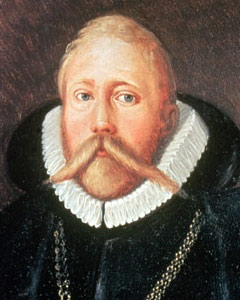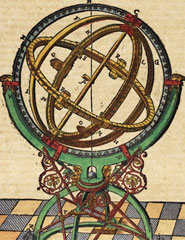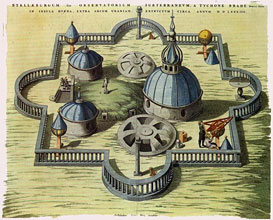
Tycho Brahe
1546 - 1601
Alchemist, astrologer, astronomer, supporter of the geocentric (Earth-centered) theory of the Solar System.
Designer and builder of astronomical instruments.
Made some of the most accurate observations of planetary positions which would eventually prove useful to his predecessors.

Tycho Brahe was born on December 14, 1546 in Skane, Denmark, which is now a part of Sweden. His family was a member of the nobility in Denmark. Tycho raised by his paternal uncle and eventually became his heir. He eventually attended universities of Copenhagen and Leipzig and later, the universities of Wittenberg, Rostock, and Basel. His noble parents had intended him to become a lawyer and diplomat. In 1566, he lost part of his nose in a duel with another student over mathematics. He later had a metal insert made to replace the missing part. He was known to carry glue around with him to help keep the nose on. It has long been thought that this prosthetic nose was made from silver, but recent evidence suggests that it was actually made from brass.
In 1572, an observation of the constellation Cassiopeia revealed to Tyco a new star. This was a supernova, and he published a short paper about it in 1574. The star is usually referred to today as "Tycho's supernova". It was this event that turned his interests to astronomy. Tycho traveled to Germany to meet with other astronomers. When he returned, he accepted a financial offer from King Frederick II of Denmark to build an observatory. The observatory was built on the small island of Hven near Copenhagen. It was called Uraniburg, and it soon became one of the finest observatories in all of Europe. The observatory housed several large and exceptionally accurate instruments with which Tycho observed the heavens for nearly twenty years. During this time, he built and calibrated new instruments and made rigorous nightly observations. Then, after a disagreement with the new King of Denmark, he closed down Uraniburg and left Denmark. He eventually settled in Prague in 1599.

Later that year, Tycho was appointed as the Imperial Mathematician to the Holy Roman Emperor in Prague. He later took on an assistant named Johannes Kepler to help him with his calculations. He was attempting to prove the validity of his new cosmological model with the Earth at the center of the Solar System. He had formulated his own model of the Solar System which was somewhat of a merger of the geocentric (Earth-centered) and heliocentric (Sun-centered) models. In Tycho's system, the Earth was at the center of the Solar System. The Moon, Sun, and stars all revolved around the Earth. But unlike the the previous geocentric model, Tycho's model had the rest of the planets revolving around the Sun. This Tychonic system became popular early in the seventeenth century among those who rejected both the Copernican heliocentric system and the Ptolematic heliocentric system. In 1601, Tycho died, and his instruments were stored away and eventually lost. Afterwards, Kepler succeeded him as Imperial Mathematician. Tycho's observations had been much more accurate than any made before him. The accuracy of these observations allowed Kepler to deduce his three laws of planetary motion. Without Tycho's accurate observations, Kepler would have never discovered that the planets move in elliptical orbits. It was his techniques, methods, and instruments that helped pave the way toward a new understanding of the heavens.




